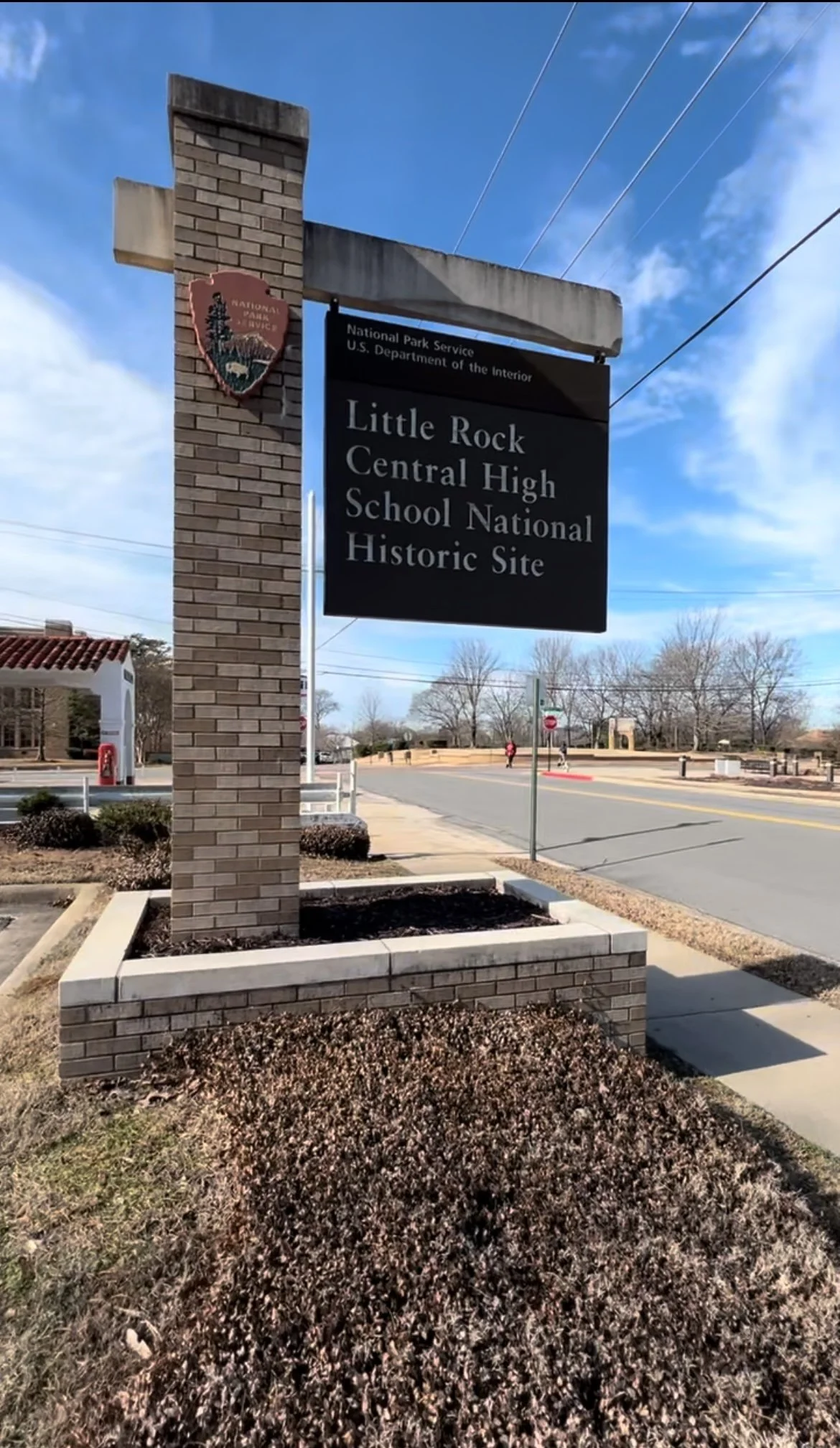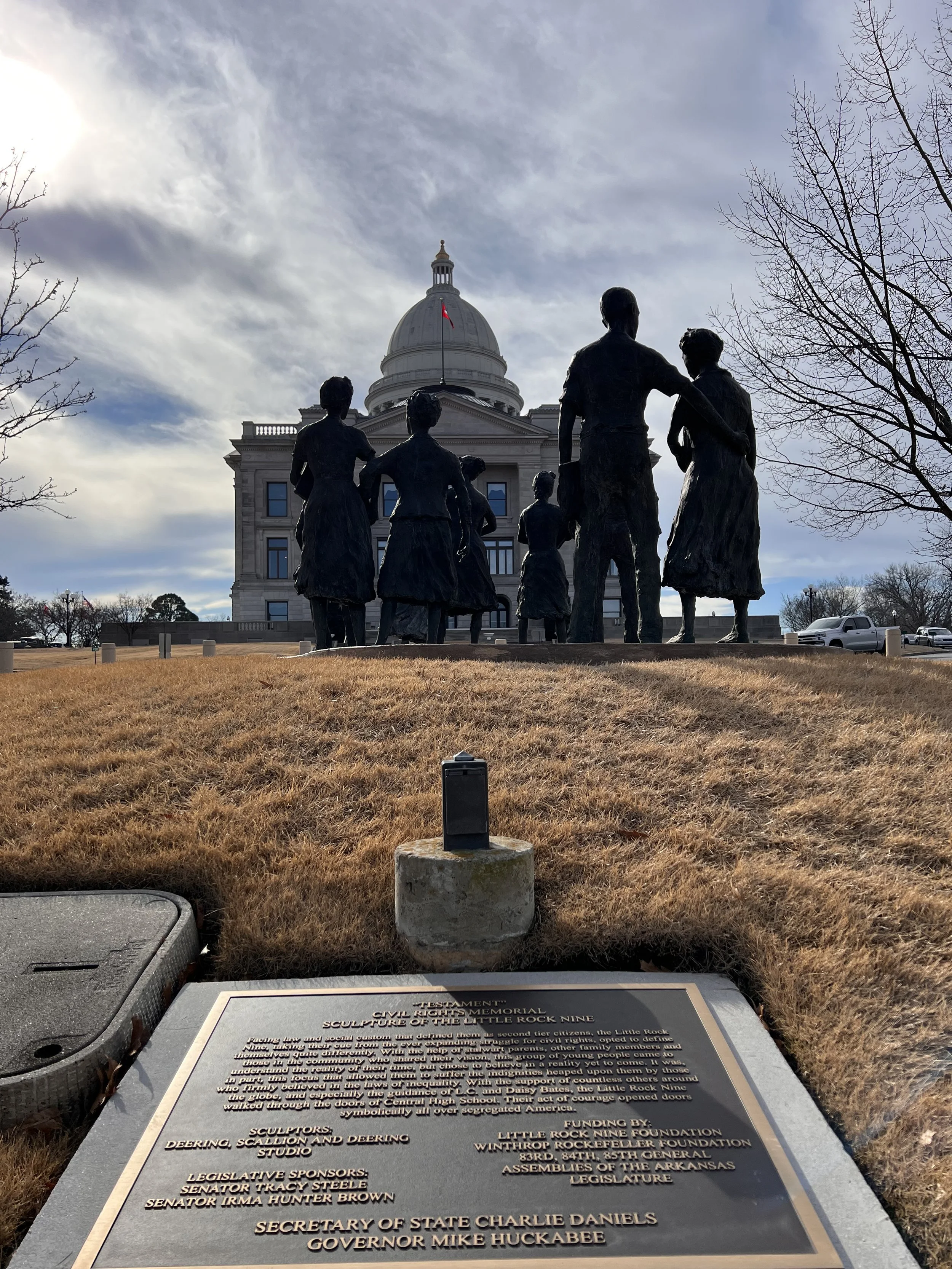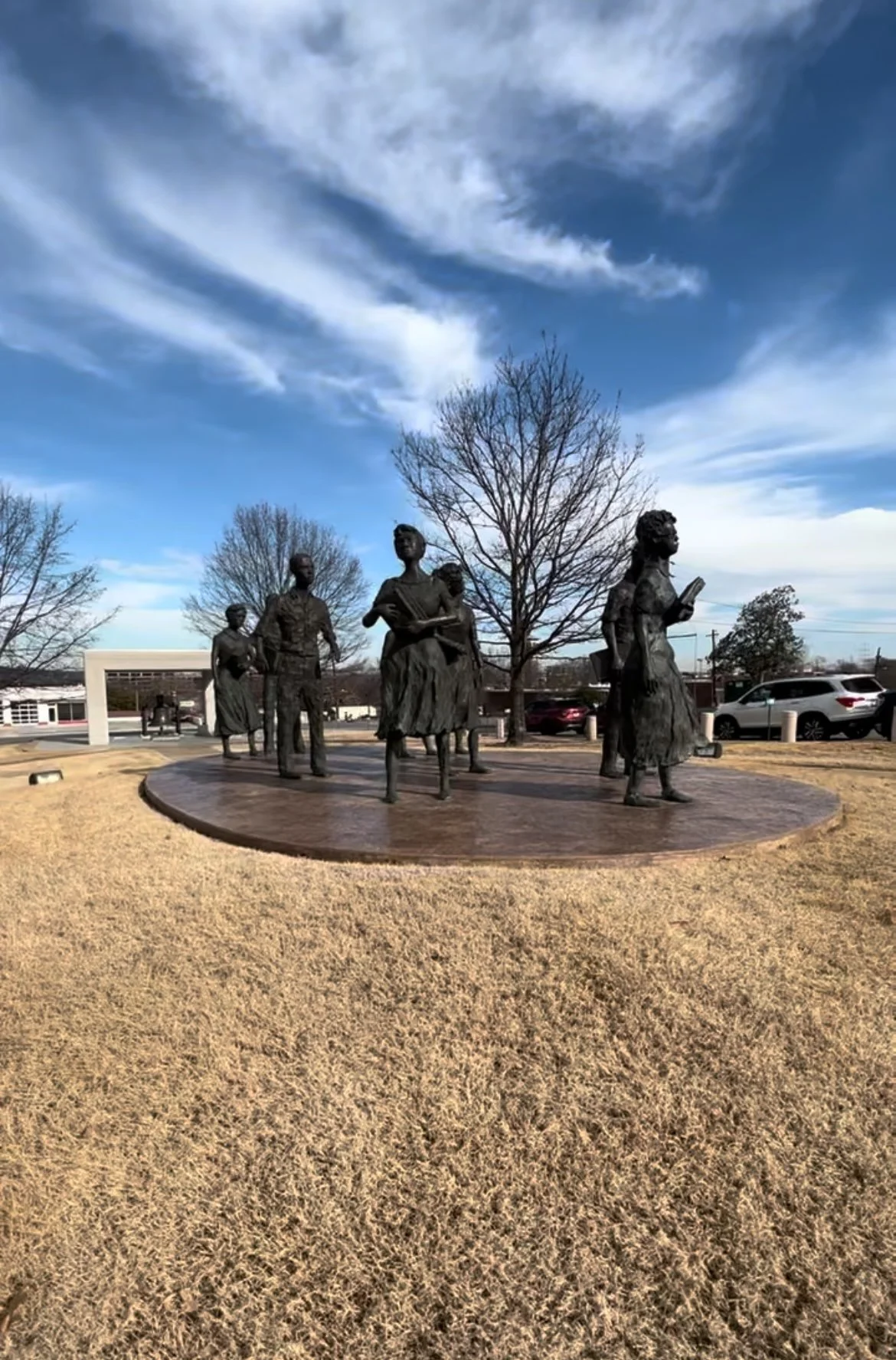Exploring Civil Rights History in Little Rock
The inspiration behind the places we wander shifts over time. Many of our journeys on the map began with a family trip as kids. With age, those family trips become trips with friends to the places we heard about as teens (hi, New Orleans) and far away destinations we can now pay for ourselves.
The inspiration I was not expecting to find was a book I read with my students. However, soon after leaving teaching, I found myself seeking out the Civil Rights Memorials in Little Rock that I had read about with my Sophomores a few years before.
Civil Rights Memorials in Little Rock
When I left teaching, I told myself I still wanted to support educators in some way. I wasn’t sure what that would look like, but a year and a half after leaving the classroom I found myself heading out to support teachers in Arkansas.
I found a job that not only allowed me to support educators but also wanted to pay me to travel. Now, the excitement of corporate travel has worn off a bit, but on that first trip - I was all in. Especially on that first trip to Arkansas.
While the school I supported was not located in Little Rock, the closest airport to the rural town of Star City, Arkansas was the Clinton National Airport in Little Rock. This meant staying in Little Rock for a night after driving back to the city.
While I could have taken the first flight home the next morning, I did what any wanderer would do in a new city and booked the latest flight home - then I set out to explore as much of Little Rock as possible in one day. In complete transparency, I was exhausted at the end of the day and ended up dropping quarters into one of those massage chairs at the airport. I still would have done it though, although not for the reasons you may think.
I could tell you I would have done it for the experience of wandering down President Clinton Ave while exploring shops and restaurants at the River Walk Market. I could say it was the local cafe in the Soma district where I had a true Southern breakfast. or the quick drive I took to Pinnacle Mountain State Park.
All of these were fun experiences from my day in Little Rock, Arkansas. However, they weren’t what made Little Rock unforgettable. What made Little Rock unforgettable was standing in front of one of the most significant sites of the American Civil Rights Movement - Little Rock Central High School.
Little Rock Nine Book
Little Rock Nine book, Warriors Don’t Cry by Melba Patillo Beals
*This is an affiliate partner link to Amazon
To understand how I found myself standing in the shadows of this national historic landmark, we have to go back to my days in the classroom. As a former English teacher, I was introduced to Central High while reading the book Warriors Don’t Cry with my students. I was introduced to the book by a fellow teacher.
The year I started teaching Sophomores one of my fellow teachers shared her lesson plans for Warriors Don’t Cry. It was a book she had taught for years, and I was grateful for her support. Unfamiliar with the book though, it’s highly probable I wasn’t overly excited to take on reading and preparing a new text. The other teacher was right in suggesting this book about the Little Rock Nine though.
It feels wrong to say it was a joy to read Warriors Don’t Cry because what happened to Melba Pattillo Beals and the rest of The Little Rock Nine was horrific. What I will say is that I am grateful that I read it, and I appreciate the opportunity I had to share it with my students that year.
Warriors Don’t Cry is a memoir by Melba Patillo Beals - one of the Little Rock Nine. If you are unfamiliar with the Little Rock Nine, they were a group of nine African American students who integrated Central High School in Little Rock, Arkansas, in 1957.
In the book, Beals recounts the acts of racism, violence, and hostility that she and the rest of the Little Rock Nine faced over the course of the school year. While reading the book, it is hard to digest the events detailed - especially when you are reminded these were real-life experiences of high school students, children, rather than stories of fiction. It is the light that Beal’s firsthand account sheds on these unimaginable acts in United States History that reminds you of how important the Civil Rights Movement was and how important it is for us to continue to learn about history to help us continue to progress in the present.
Little Rock Central High School
Central High School where nine African American students helped fight segregation in 1957
Although it has been years since teaching Warriors Don’t Cry, it was clearly a book that stayed with me. So, when I found out I would be traveling to Little Rock for my new role in education - it felt like a sort of full-circle moment of my past inspiring my future.
When I headed out to see Central High School, I wasn’t sure what to expect. I knew it was still an active school, so I figured I would not get to see the inside. I certainly did not expect how impactful simply standing in front of the building would be, though.
When I arrived, school was still in session so the grounds outside were quiet. No school buses or cars. No students or teachers. Just stillness - a quiet January morning in the south that was full of sunshine and that little bit of warmth many of us forget is possible in January.
It felt like the quiet offered an air of reverence. Not in a soft way but in a way that magnified the significance of this building and the stories it holds.
As I thought back to standing at the foot of that architectural phenomenon, it made me wonder if the world knew the building needed to match the significance of the change that would take place within its walls. Moreover, if the world knew the walls needed to be strong enough to withstand the abuse it would witness while at the same time protecting the nine black students - children - that bravely chose to continue to step through its doors each day.
It looks as if it was already selected as a memorial before it became the home to one of the most significant historical events in Civil Rights history.
Little Rock Nine Museum
Entrance to Little Rock Central High School National Historic Site
With the background I had from reading Warriors Don’t Cry, just standing in front of Central High School would have been worth the visit. Honestly, that’s as much as I thought I would get to experience when I set out to see it. So, I was intrigued when I looked across the street and saw a visitor center sign for a national historic site.
I have not traditionally been a wanderer who seeks out national parks or sites. I think it’s because, until this trip, I didn’t realize how many different types of historical sites could be considered a national park. In my naivete (and maybe my root because of my Utah roots) my brain always defaulted to the word “park” - picturing vast landscapes that take a bit more commitment to explore than a quick afternoon excursion.
The National Historic Site Visitors Center that sits across from Central High opened my eyes to a whole new travel experience - creating a curiosity not only about what I can see at other historic sites but also about what I can learn.
The unassuming building that sits across from the historic memorial is not just filled with lists of facts, but stories of the people who made history at this location. Stories that are showcased in film footage, images, and memorabilia.
Even though it’s an easy walk around the museum, you could spend at least an hour taking in each story and learning about the experiences of each member of the Little Rock Nine: Melba Pattillo, Ernest Green, Elizabeth Eckford, Minnijean Brown, Terrence Roberts, Carlotta Walls, Jefferson Thomas, Gloria Ray, and Thelma Mothershed.
A display inside the Little Rock Nine museum that explains how the fight to end segregation went beyond the Crisis at Central.
While the focus of the museum is on the history of the Little Rock Nine, the events that took place at Little Rock Central High School were part of a bigger story in United States history and the fight for African American civil rights. The museum highlights the stories of other important figures such as Dr. Martin Luther King Jr. and shows how other events framed what took place at Central High School.
From the decision to integrate the previously all-white high school after the 1957 Brown v. Board of Education decisions to the pushback by then Arkansas Governor Orval Faubus to President Eisenhower being forced to provide federal troops (and Arkansas National Guard) as protection for the nine students - the museum provides a full account of the events leading up to and following the sacrifices of the Little Rock Nine.
Little Rock Nine Monument
“Testament” Civil Rights Memorial at the Arkansas State Capitol honoring the Little Rock Nine.
If you only have time to visit one Civil Rights Memorial in Little Rock then a trip to the Little Rock Central High School National Historic Site is the place to go. However, it is not the only memorial for the Little Rock Nine that you can explore.
The initial destination for my one day in Little Rock was the Little Rock Nine Monument at the Arkansas State Capitol. The monument, “Testament: The Little Rock Nine Monument” was erected in honor of Melba Pattillo, Ernest Green, Elizabeth Eckford, Minnijean Brown, Terrence Roberts, Carlotta Walls, Jefferson Thomas, Gloria Ray, and Thelma Mothershed. It is a dedication to their bravery and sacrifice for stepping into the halls of Central High School in 1957 - and continuing to walk those halls despite the persecution they faced.
Located on the northern side of the Capitol building the monument faces the governor’s office window. Although, if I am being honest, the location left me wondering. The statues are beautiful and I had the gift of seeing them showcased under the noon sun. However, as the first Civil Rights monument located on any state capitol grounds in the South, I expected it to be in a more prominent location. A little difficult to find and a bit distanced from the Capitol building - it felt like the location didn’t quite represent the gravity of what the monument represents
That was just my personal experience, though. As travelers, one experience that doesn’t resonate with me may resonate with you. So, even though my unforgettable experience was at Central High School yours may be at the Little Rock Nine Monument. Therefore, if you make your way to Little Rock and have time to do both then definitely take time to visit both the Little Rock Nine Monument at the Capitol building and the Little Rock Nine Museum at Central High School.
Memorial honoring the members of the Little Rock Nine: Melba Pattillo, Ernest Green, Elizabeth Eckford, Minnijean Brown, Terrence Roberts, Carlotta Walls, Jefferson Thomas, Gloria Ray, and Thelma Mothershed.
I don’t think many of us can deny the connection between learning and travel. It feels impossible (or improbable) to experience a new place and not feel it shift your thinking in some way. Sometimes those shifts are small moments in how we see ourselves and sometimes they are big moments in how we see the world around us. Sometimes they are simply little reminders of things we have forgotten.
While exploring Little Rock, and other small Arkansas towns beyond the city, I was reminded of the power of storytelling. I was reminded of how a book can impact you (which, I needed to be reminded of). I experienced a new awareness of an important time in history and came to appreciate how the history of a country can be so deeply tied to not only a single city but a small group of people.
Beyond the power of a single book guiding my travels, I also experienced the more familiar shifts in thinking that come from visiting a new city. I was surprised by the artsy vibes of downtown Little Rock and intrigued by the contrast to the small rural towns only two hours away. I was also not so pleasantly surprised by the aggressiveness of drivers on the wide-open country highways.
Despite the honks saying I wasn’t going fast enough through the countryside, Arkansas provided an unexpected opportunity for learning while reminding me to continue seeking uncommon inspiration for travel.









